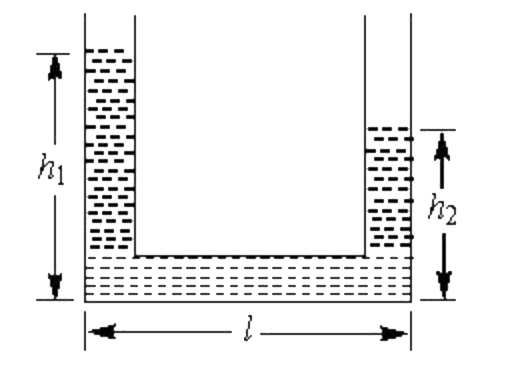Two ends of a U-tube are closed. Density of liquid is ρ and surface tension is T. Radius of left arm is r1 and that of right arm is r2. Pressure of gas at left arm is P1 and that at right arm is P2. Then P1−P2 is

hρg+2T[1r1−1r2]
hρg−2T[1r1−1r2]
hρg
hrg+2T[1r1+1r2]
The correct Answer is:A
Topper's Solved these Questions
Similar Questions

In the U−tube, radius of one arm is R and the other arm is 2R. Find the difference in water level if contact angle is θ=60∘ and surface tension of water is T.
View SolutionTwo capillaries of small cross section are connected as shown in the figure. The right tube has cross sectional radius R and left one has a radius of r(<R). The tube of radius R is very long where as the tube of radius r is of short length. Water is slowly poured in the right tube. Contact angle for the tube wall and water is θ=0∘. Let h be the height difference between water surface in the right and left tube. Surface tension of water is T and its density is ρ.

(a) Find the value of h if the water surface in the left tube is found to be flat.
(b) Find the maximum value of h for which water will not flow out of the left tube .
View Solution
Knowledge Check
A vertical U-tube contains a liquid of densityρ and surface tension T. if the radius of the meniscus of liquid in the limbs of the U-tube are R1 and R2 find the difference in the liquid column in the limbs.
AΔh=T(R1−R2)ρgR1R2BΔh=2T(R1−R2)ρgR1R2CΔh=2T(R1+R2)ρgR1R2DΔh=4T(R1−R2)ρgR1R2Who is to the immediate right of P among five persons P, Q, R, S and T facing North?
I. R is third to the left of Q and P is second to the right of R.
II. Q is to the immediate left of T who is second to the right of P.Athe data in statement I alone are sufficient to answer the question, while the data in statement II alone are not sufficient to answer the question,Bthe data in statement II alone are sufficient to answer the question, while the data in statement I alone are not sufficient to answer the question,Cthe data either in statement I alone or in statement II alone are sufficient to answer the question,Dthe data given in both statements I and II together are not sufficient to answer the question,A liquid of density ρ is filled in a U-tube is accelerated with an acceleration a so that the height of liquid in its two vertical arms are h1andh2 as shown in the figure. If l is the length of horizontal arm of the tube, the acceleration a is
 Ag(h1−h2)2l towards rightBg(h1−h2)2l towards leftCg(h1−h2)l towards rightDg(h1−h2)l towards left
Ag(h1−h2)2l towards rightBg(h1−h2)2l towards leftCg(h1−h2)l towards rightDg(h1−h2)l towards left
The vertical arms of U - tube have unequal raidus R and r (R>r) . If a liquid of surface tension T and density ρ rests in equillibrium inside the U - tube , find the level difference h between the meniscuses in the two arms .
View SolutionThe vertical arms of U - tube have unequal raidus R and r (R>r) . If a liquid of surface tension T and density ρ rests in equillibrium inside the U - tube , find the level difference h between the meniscuses in the two arms .
View SolutionA liquid of density ρ is filled in a U-tube is accelerated with an acceleration a so that the height of liquid in its two vertical arms are h1andh2 as shown in the figure. If l is the length of horizontal arm of the tube, the acceleration a is

View SolutionLength of a horizontal arm of U-tube is L and ends of both the vertical arms are open to atompsheric pressure P0, A liquid of density ρ is poured in the tube such that liquid just fills the horizontal part of the tube as shown in figure . Now one end of the opened ends is sealed and the tube is then rotated about a vertical axis passing through the other vertical arm with angular speed ω0. if length of each vertical arm is a and in the sealed end liquid rises to a height y, find pressure in the sealed tube during rotation.
View SolutionThe U-tube in figure contains two different liquids in static equilibrium, water in the right arm and oil of unknown density ρx in the left. If/=135 mm and d=15 mm. Density of the oil is

View Solution
